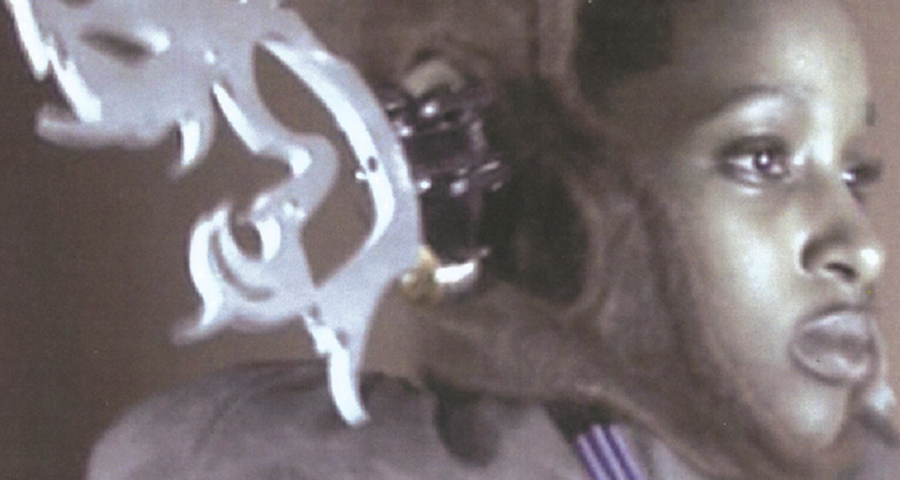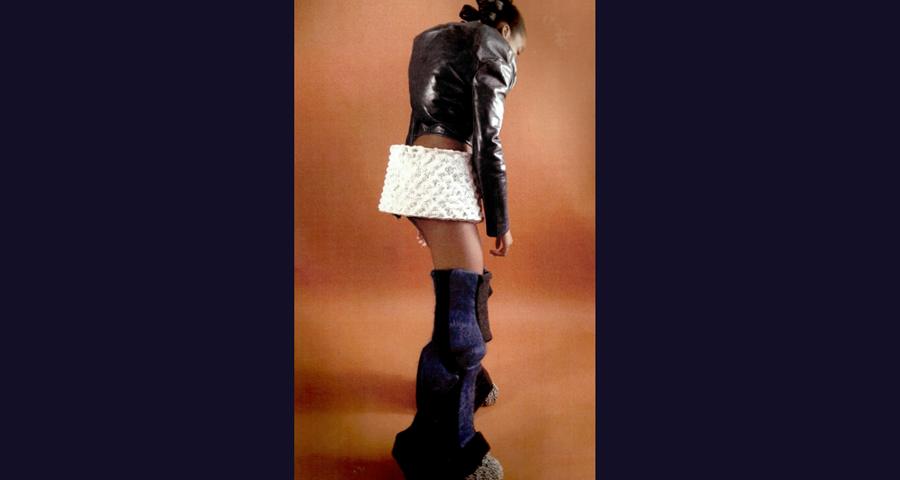Interview Objects of Desire: Surrealism and Design 1924 - Today
Yasmina Atta: Afro-Surrealism
Delve into the world of fashion designer Yasmina Atta as she explores her inspirations, influences and ideas on modern day Surrealism with Ayoola Solarin, an arts and culture writer.
As a recent womenswear graduate of Central Saint Martins, Atta's garments and accessories draw on aspects of her Nigerian heritage blended with futuristic and mythological elements.
Estimated reading time: 5 minutes

When someone says 'surreal', what are the first three words that come to mind?
Spirit, magic and truth.
Your 2020 graduate collection, called Kosmos in Blue, felt like an amalgamation of your Nigerian heritage and Western culture. How do you find the balance of inspiration in your design process?
When I was living in Nigeria, my daily life was a combination of both Nigerian and Western influences. I feel it is always important in my work to have a balance. Even if something is playful, there might be a kind of manipulation of technique going on, or I might use a more experimental approach to materials, bend and mix things. [For Kosmos in Blue] I worked with mechanisms to make the parts move, and a lot of pieces are quite sculptural. I used heavy materials, like leather, metals, wools – quite decadent materials that I try to make move in an elegant way, which is quite strange because of their weight. I also look a lot at Nollywood films, where people mix a lot of different styles. It’s quite instinctual, the way I work.
'At the moment I am looking a lot more at antique objects for inspiration, but in my personal life I do take inspiration from video-game visuals.'

Surrealism and Design Now: From Dalí to AI deals with what the movement was exploring. You mentioned Nollywood as inspiration, which is arguably peak absurdity. Can you talk a little bit about how absurdity and Surrealism play a role in your work?
I became interested in Surrealism because of the way the artists put an emphasis on the now. At the time I was working on Kosmos, I was looking at a lot of African cinema. They have these moments in them, mystical and magical, but in a way that’s so real. In terms of Afro-Surrealism, there are a lot of conversations about what was happening in post-colonial society that made daily life quite surreal, but also there were quite serious conversations. I feel very attracted to it because of how a mystical landscape can be so relatable to reality somehow. The combination of rituals and traditional medicine in Nigeria (Juju) and the European culture of the idealism of travelling and going away – I like all those combinations of daily life. I am attracted to the fantastical and ritualistic aspect of Surrealism that grounds you in real life.
'I like to combine things that don't make sense. I think this is the more playful side of my work which I am embracing now.'
Where Afrofuturism deals with the future, science and the advancement of technology, Afro-Surrealism in contrast deals more with the present. Do you find yourself looking more at the future or focusing more on the now?
I think a lot about right now. I feel it’s very grounding for me, especially with the internet and social media; you almost start to see things ten steps ahead, and because of this you are not really in the moment. Many of the older generation feel bad for us. Lately, I’ve been trying to be in the now and that’s why I am interested in Afro- Surrealism rather than Afrofuturism, which doesn’t feel as grounding. It feels almost escapist. [With Afro-Surrealism] it’s quite hard to define because it doesn’t really have an aesthetic to it, which I kind of love.

At the beginning of this interview, you were asked what three words come to mind when you think of Surrealism, and you said ‘spirit’, ‘magic’ and ‘truth’. I feel we’ve talked about spirit and magic, so what truth do you look to impart to your work?
I try to have an honest approach. We’ve mentioned the playful aspect of my practice, and at a certain time I felt pressure to have a specific discourse behind what I was doing – forced to make something political, or that everything must mean something. I think it’s important to be able to create without feeling the pressure to say something or to stand for something or have a political agenda. The truth comes from being genuine about making things and allowing people to interpret them how they’d like, rather than me imposing my idea of the work I am making. I’d rather the viewers make up their own minds and decide for themselves. Whether that’s negative or positive, I don’t mind. I am always really interested in knowing what people think, and I want to know their interpretation of my work – which sometimes is even more truthful than mine.
Explore the book
Surrealism & Design Now
Published to accompany the exhibition Objects of Desire: Surrealism and Design 1924 – Today, the publication celebrates Surrealism’s enduring legacy featuring groundbreaking fashion by Mary Katrantzou and Dior, as well as British designs by Tim Walker, Jonathan Trayte and Vince Fraser. Edited by Curator Kathryn Johnson and designed by Alexander Boxill Studio.
Discover more
6 Surrealist Chairs from #ObjectsOfDesire
From a giant eye sculpture that doubles as a chair to one inspired by a child's game - Surrealist furniture comes in all shapes and form. Extravagant, mind-boggling and highly symbolic, here's our top picks of Surrealist chairs from #ObjectsOfDesire.
Estimated reading time: 2 minutes
The exhibition
Book now: Until 19 FEBRUARY
Objects of Desire: Surrealism and Design 1924 – Today
Delve into the dreamlike relationship between Surrealism and design in this century spanning celebration of surrealist objects of desire. A Vitra Design Museum Exhibition.
Images: Yasmina Atta, Kosmos in Blue, 2020